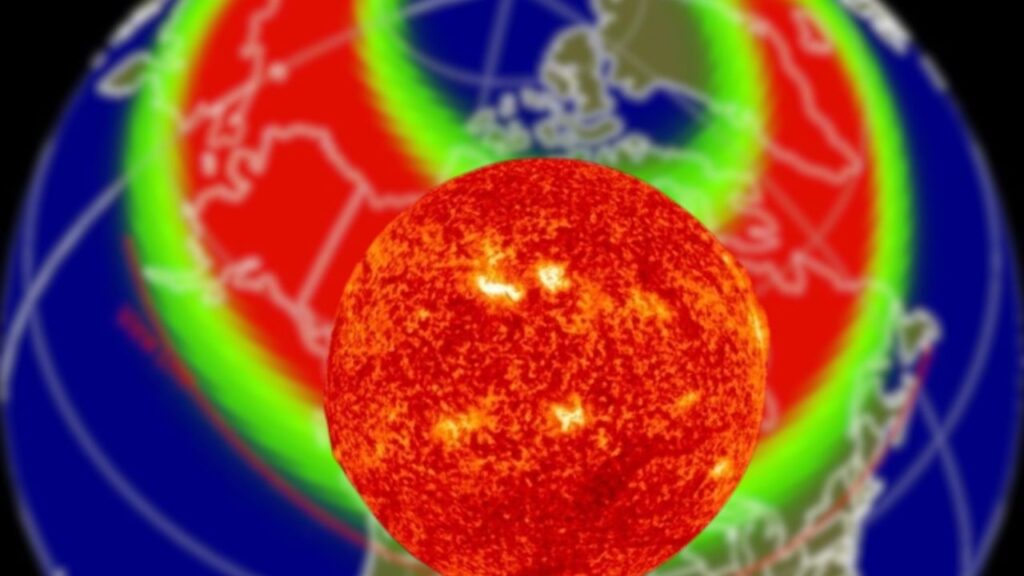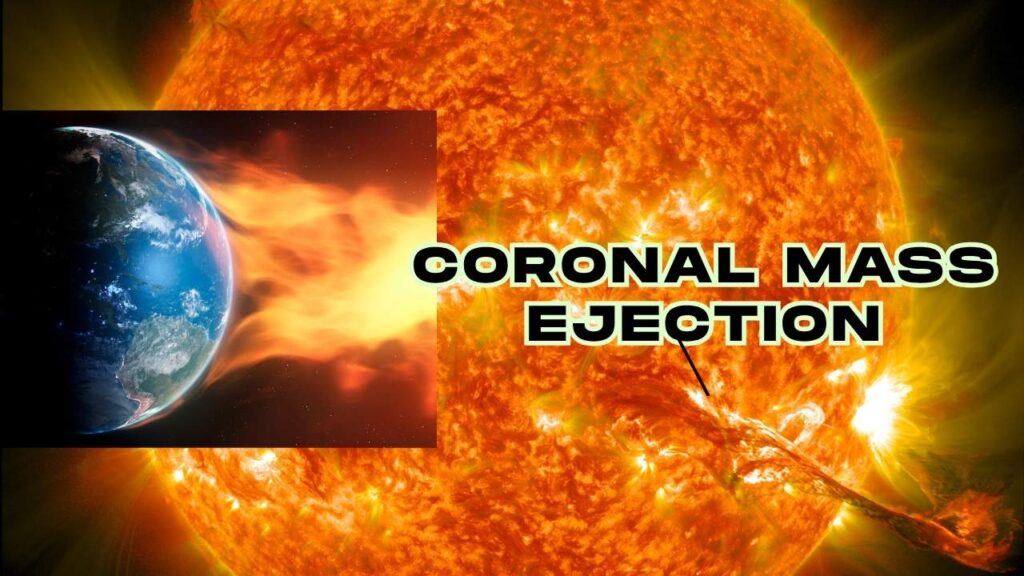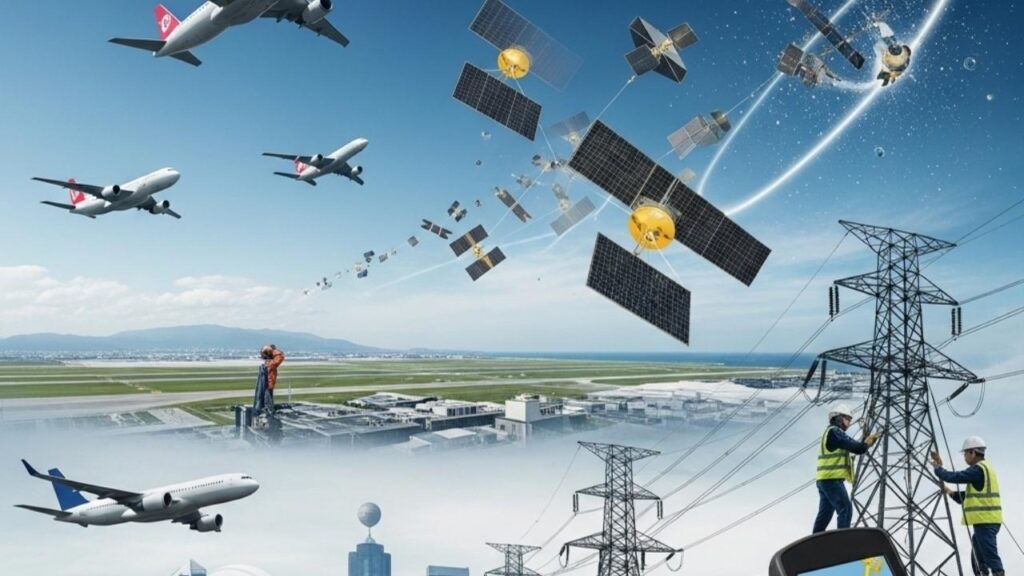Coronal Mass Ejection Triggering Rare G4‑Level Geomagnetic Storm: On June 11, 2025, a violent solar eruption launched a massive coronal mass ejection (CME) toward Earth, triggering a rare G4-level geomagnetic storm. This event, among the most intense of the current solar cycle, sent shockwaves through the space weather community—and had real-world implications for satellites, power grids, and skywatchers.

This article explains what happened, why it matters, and what you can do to stay informed and protected during space weather events. Whether you’re a student, an engineer, or a curious observer, we’ll break it all down.
Coronal Mass Ejection Triggering Rare G4‑Level Geomagnetic Storm
| Aspect | Details |
|---|---|
| Event Date | CME erupted: June 9, 2025 Storm peak: June 11, 2025 |
| Storm Level | G4 (Severe) on NOAA’s five-level scale |
| CME Speed | ~1,700–1,900 km/s |
| Aurora Visibility | As far south as New Mexico, California, Kansas (Northern Hemisphere) and similar latitudes in the Southern Hemisphere |
| Impacted Systems | Satellite navigation, GPS accuracy, high-frequency radio, power grids |
| Historical Context | Comparisons: Carrington Event (1859), May 2024 G5 storm |
| Further Reading | NOAA Space Weather Prediction Center |
The June 11, 2025 G4 geomagnetic storm served as a powerful reminder that solar weather is more than just science—it’s something that can affect your phone, your flight, your power grid, and even your view of the night sky.
Staying informed, preparing in advance, and responding quickly are the keys to managing these events. Whether you’re managing a satellite, maintaining a transformer, or just hoping to catch an aurora, knowledge is your best defense.
What Is a Coronal Mass Ejection?
A coronal mass ejection (CME) is a giant cloud of plasma and magnetic field released from the Sun’s outer atmosphere. When aimed directly at Earth, it can reach our planet in just 15 to 72 hours. Upon impact, it disturbs Earth’s magnetosphere, causing geomagnetic storms.

These storms are graded by NOAA from G1 (minor) to G5 (extreme). A G4 storm, like the one on June 11, is considered severe, capable of causing real disruptions to systems we rely on every day.
Why This Matters
Auroras: These colorful displays of light in the sky—commonly seen near the poles—were visible far beyond their usual range. People reported sightings in states like California, Kansas, and New Mexico.
Satellite and GPS Interference: CME-driven storms can inject high-energy particles into Earth’s magnetosphere, disrupting satellites, degrading GPS signals, and causing navigational errors.
Power Grid Strain: Geomagnetically induced currents (GICs) can overheat transformers and disrupt long-distance transmission lines, increasing the risk of power outages.
Radio Communication Disruption: High-frequency (HF) radio—used in aviation, maritime operations, and the military—can go dark during geomagnetic storms due to increased ionospheric activity.

Professional Perspective: What You Should Know
Advanced Preparation Steps
Real-Time Monitoring:
Subscribe to alerts from NOAA SWPC or NASA’s CCMC. These platforms use satellite data (like GOES-R) to monitor solar winds, magnetic fields, and radiation levels.
Satellite & Navigation Readiness:
Operators should initiate “space weather mode” to safeguard onboard systems. Reschedule satellite maneuvers during peak storm periods and rely on redundant GPS backups.
Power Grid Protection:
Utilities can reduce stress on transformers by re-routing loads, deploying real-time GIC monitoring, and pre-cooling systems to minimize heat stress.
Communication Network Resilience:
Use frequency diversity and satellite communication backups to ensure HF radio and GPS alternatives remain functional.
Public & Emergency Preparedness:
Government agencies can push alerts via social media, mobile apps, and national broadcast systems. Encouraging calm, accurate information helps maintain public confidence.
Real-Life Example: Satellite Operations
One satellite operator noticed high radiation levels beginning June 10. By switching to low-power mode and delaying transmission-intensive tasks, they avoided a critical system reset. The satellite returned to full function within hours after the storm subsided—proving the value of real-time response.
Grid Management During a G4 Storm
In the U.S. Mid-Atlantic region, a major utility preemptively rebalanced the load across their network. Engineers activated GIC simulations, monitored transformers for overheating, and rerouted power in real-time. No failures occurred—demonstrating that preparedness pays off.
Practical Guide: Space Weather Readiness
What is a G4 geomagnetic storm?
A G4 storm is classified as “severe” and ranks second-highest on the NOAA scale. It can affect power systems, GPS, satellites, and cause auroras well beyond the poles.
Step 1 – Monitoring
- Use NOAA SWPC and NASA CCMC for alerts.
- Track solar wind speed, magnetic field changes, and proton flux via satellite data.
- Utilities and airlines should monitor ground magnetometer readings.
Step 2 – Alerting & Communication
- Set up SMS/email alerts for your team.
- For critical infrastructure, establish internal alert levels based on G-scale forecasts.
- Use clear, factual language in public statements.
Step 3 – Risk Mitigation
- Satellites: Activate radiation shielding protocols.
- Utilities: Shift load and monitor real-time transformer status.
- Airlines: Adjust flight paths or comms frequencies as needed.
Step 4 – Operational Adjustments
- Pause non-essential satellite activity.
- Reduce grid load on vulnerable components.
- Deploy alternative HF communication methods in case of outages.
Step 5 – Post-Storm Review
- Download and analyze NOAA storm reports.
- Log system anomalies (GPS drift, transformer heat) for benchmarking.
- Update preparedness protocols as needed.
Quantum Mechanics Centennial Spurs International Year Of Quantum Science & Technology
Oxford Physicists Achieve Record-Low Quantum-Bit Error Rate: One In 6.7 Million
FAQs About Coronal Mass Ejection Triggering Rare G4‑Level Geomagnetic Storm
How rare are G4 storms?
G4 events are rare but more likely during solar maximum, which occurs every 11 years. While not common, they’re not unprecedented—similar events occurred in May 2024 and March 2015.
Do G4 storms affect smartphones or personal devices?
Generally no. Personal electronics are well shielded. However, GPS accuracy on phones and car systems can degrade temporarily.
Should I worry about flying during a geomagnetic storm?
Airlines sometimes reroute polar flights to avoid potential radio blackouts. Flights closer to the equator are largely unaffected. Commercial passengers usually don’t experience noticeable changes.
How can I prepare for future solar storms?
Follow alerts from NOAA SWPC, install aurora notification apps, and consider keeping backup power options if you live in a remote or high-latitude area.






